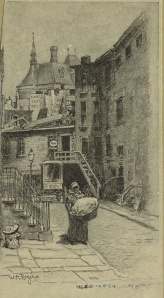 Being ensconced inside a dark bar with a pint and good conversation is many a New Yorker’s idea of heaven.
Being ensconced inside a dark bar with a pint and good conversation is many a New Yorker’s idea of heaven.
John Sloan may have felt that way too.
His famous 1912 painting “McSorley’s Bar” depicts working-class customers comfortably drinking around a wood bar (with bartender Bill McSorley, son of the original owner, who founded the East Seventh Street ale house in 1854), wiling away the hours.
It’s his most renowned McSorley’s painting, but not the only one. Sloan completed at least three more, each capturing various glimpses of loneliness and whimsy and highlighting the small moments of pleasure and respite in a workingman’s life.
“McSorley’s Back Room” also dates to 1912. “The hushed, contemplative mood of this painting echoes Sloan’s description of the bar as an oasis ‘where the world seems shut out—where there is no time, nor turmoil,'” states the Hood Museum website, quoting Sloan.
“The tavern’s founder was no longer living when Sloan discovered the place, but through this painting and a related etching Sloan appears to pay homage to John McSorley, who, according to his son, always sat there in the sun.”
In 1928, Sloan memorialized the dozen cats living at the bar in “McSorley’s Cats.” Could that be bartender Bill McSorley again, with cats badgering him for food?
With Prohibition still the rule of law, Sloan painted “McSorley’s Saturday Night” between 1928 and 1930. States the McSorley’s website: “everyone seems to have a mug in his hands.”
Sloan moved to New York in 1904 and spent many years depicting the city’s moods, from joy to isolation.
As for McSorley’s, this dusty old saloon, which famously refused to serve women until a court order in 1970, has been memorialized many times in art and literature, most famously by Berenice Abbott, Joseph Mitchell, and e.e. cummings.









